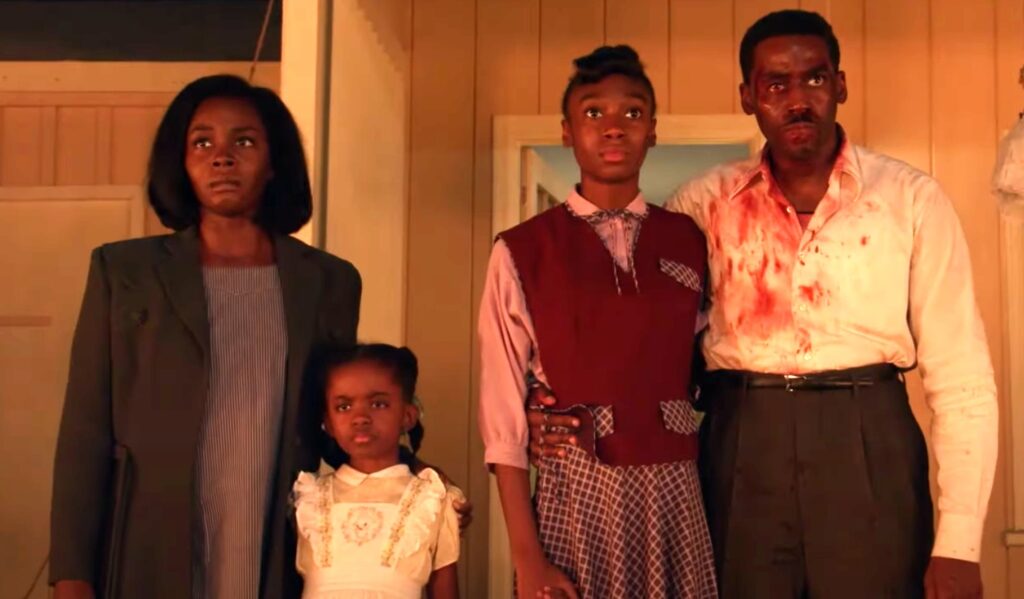I remember seeing Amazon Prime’s Them (2021) trending on Twitter the day the first official trailer came out in March 2021, and after watching the 2-minute preview, I was immediately turned off and decided that I would never watch the show. IMDB describes the plot summary as “A Black family moves to an all-white Los Angeles neighborhood where malevolent forces, next door and otherworldly, threaten to taunt, ravage and destroy them.”1 The torture alluded to in this summary is very overt in the trailer. This includes depictions of white children howling like a monkey at the daughter character (Shahadi Wright Joseph), several anti-black caricatures known as Golliwogs2 hung by mini-nooses and littered outside of the family’s home, a “Sambo-Esque” character known as the “Da Tap Dance Man” that is meant to act as the supernatural force plaguing the family, and flashes of scenes in which the family appears to be tortured physically and psychologically throughout the series. This anthology series continues to develop the “race-horror” genre and the direction that projects within this genre could be headed.

I am defining “race-horror” as a subset of the horror genre, which frames racism as the source of the horror that torments the protagonists who are people of color. When applying this definition to the show, I want to know how this visceral, horrific imagery functions as a message or theme other than the fact that black people have been physically and psychologically tortured by these devices and more for centuries in the United States? Or, in its most oversimplified form: racism is a horror story in itself that people should continue to be mindful of. I think that this intention is good by using this genre to inform and remind the general public of the horrific manifestations of racism, but using the horror genre to convey the message could go wrong at the same time.

I fear that future projects within the genre will grossly depict the most extreme methods of violent torture against their black characters to communicate the same message but offer nothing else. I find that the most provocative and compelling horror films are creative and create a unique circumstance in which well-known ideas or prevalent tropes are present, which results in a fresh, new addition to the genre. For example, I would argue a film like Jordan Peele’s Get Out (2017) meets the traits specific to this genre in which racism acts as a prevailing, evil torture device that enables white characters to kidnap, lobotomize, manipulate, and exploit black people for their gain.

Many people assumed that Them was created by Jordan Peele because of his 2019 horror film Us (2019), which has a similar aesthetic in marketing and a black family as the protagonists. The danger of comparing these two pieces of media that fall within this “race-horror” genre is that Us is mainly a psychological thriller, in which the race of the black family is not pertinent to the subject of the film. Peele has even stated that the film “is not about race” despite the plot of his previous film, Get Out (2017), where the victims’ race was a focal point.3 On the topic of Jordan Peele, I believe that the popularity and discussion generated by Get Out contributed to the increasing recognition of this subsection of “black horror” within the horror genre. Racism was a prevalent idea that drove the plot forward, while the narrative was an inventive and clever new way to address these issues within the genre.

Them does not appear to be anything that I have not seen before, which makes me concerned for future projects within the genre. The broadest generalization of the plot seems to be a 50s white neighborhood tormenting their new black neighbors but taken to the absolute extreme. I have seen this era before in television and film, which shows the intertextuality between this piece of media and other historical texts/depictions about racism within this era of the country. Even these supernatural elements presented by “Da Tap Dance Man” is not compelling enough to subvert these ideas and tropes that are already a recognizable part of the cultural forum regarding the United State’s history of racism and the manifestations of that prejudice against black people.

The reviews for the show have been mixed, with some reducing the show to being 10 hours of glorified “torture-porn” against the black characters and some arguing that the show is insightful and offers more psychological evaluations of the black family and white antagonists than it appears. There may be truth in both arguments, but I am fearful that future projects within this genre could reduce and overgeneralize these ideas to further torment black characters without adding anything new other than the message of “racism is a horror story.” Horror as a genre can torment the characters and terrify the viewers while also revealing some insight about the human psyche or present an inventive narrative. I think that is what the show is trying to accomplish, but I’ll determine that myself once I watch it.
Citations
1 IMDB. “Them.” IMDb. IMDb.com, April 8, 2021. https://www.imdb.com/title/tt9064858/.
2 Jim Crow Museum of Racist Memorabilia. “The Golliwog Caricature.” The Golliwog Caricature – Anti-black Imagery – Jim Crow Museum – Ferris State University. Ferris State University, 2021. https://www.ferris.edu/HTMLS/news/jimcrow/golliwog/homepage.htm.
3 Obenson, Tambay. “’Us’ Makes a Radical Argument for Black Identity By Ignoring It.” IndieWire. IndieWire, March 22, 2019. https://www.indiewire.com/2019/03/us-movie-jordan-peele-lupita-nyongo-1202051703/.















